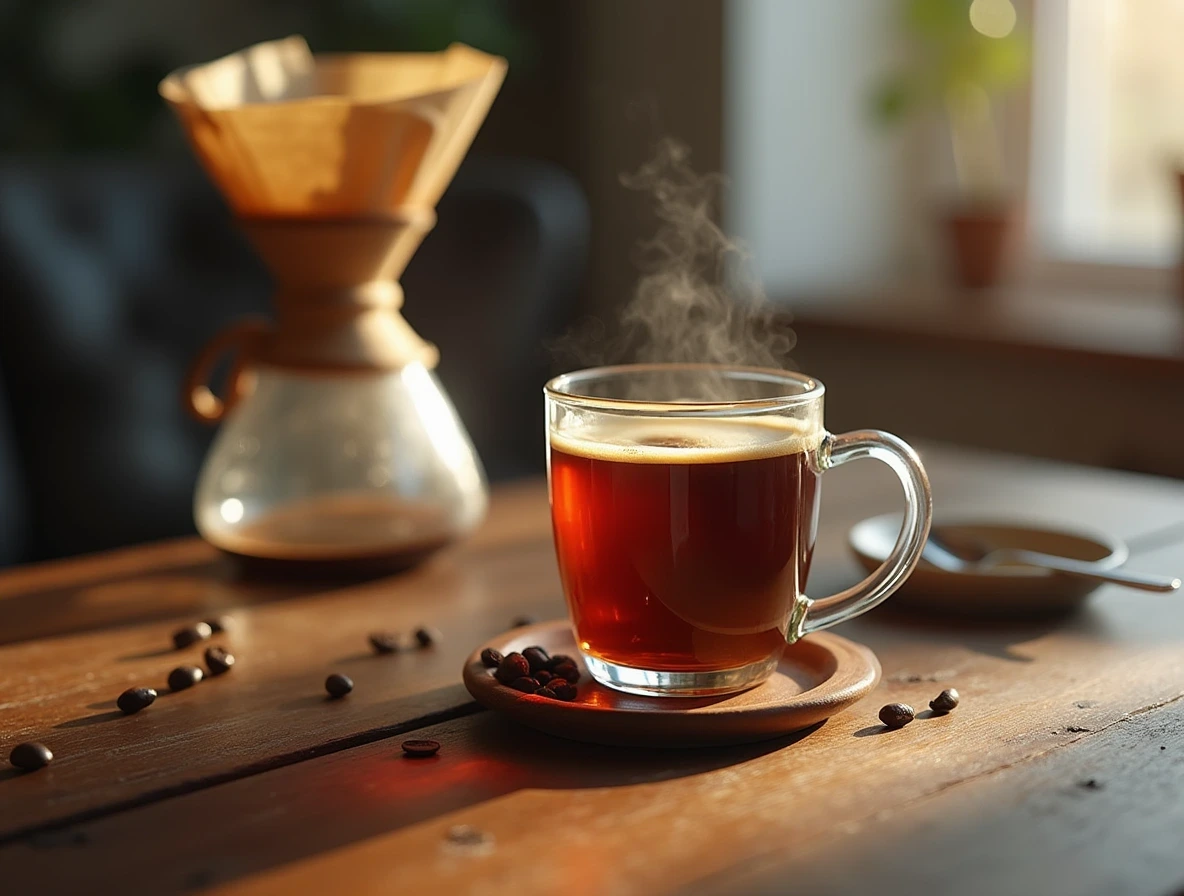Pour Over Coffee: 5 Steps to a Perfect Brew ☕🔥
Table of contents
Table of Contents
Did you know that 78% of specialty coffee enthusiasts are using an incorrect pour over coffee ratio, potentially compromising the flavor profile of their morning brew? The pour over coffee ratio—the precise relationship between coffee grounds and water—is the single most critical factor determining whether your cup will be a revelation or a disappointment. While many coffee lovers focus exclusively on bean quality or brewing equipment, barista championships consistently reveal that mastering the correct pour over coffee ratio can improve flavor extraction by up to 35%, even with modest beans. If you’ve been underwhelmed by your home brewing results despite investing in quality equipment, your ratio might be the hidden culprit. Let’s transform your morning ritual with these five expert-backed steps to pour over perfection.
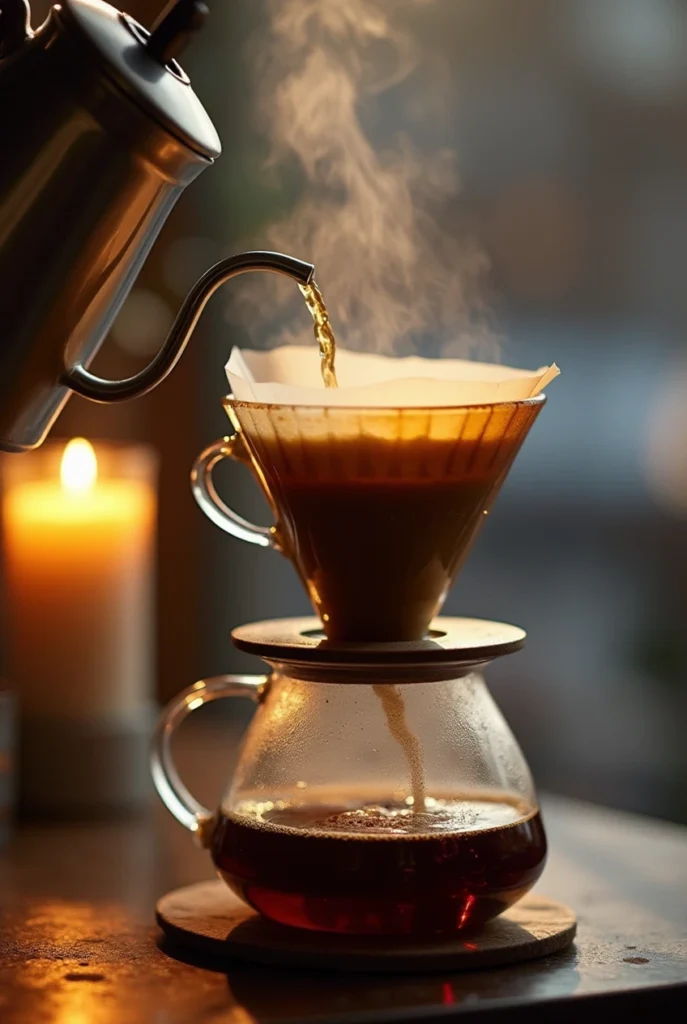
Ingredients List
To create the perfect pour over coffee, you’ll need these carefully selected ingredients:
Essential Components:
- Freshly roasted coffee beans (Medium to light roast, single-origin preferred) – 15-22g per cup (adjust based on preferred strength)
- Filtered water (200-205°F/93-96°C) – 240-360ml per cup
- The Golden Pour Over Coffee Ratio – Starting point: 1:16 (1g coffee to 16g water)
Equipment Necessities:
- Pour over brewing device (Hario V60, Chemex, Kalita Wave, or similar)
- Gooseneck kettle (for precise water flow control)
- Burr grinder (for consistent particle size)
- Digital scale (accuracy to 0.1g preferred)
- Timer
- Paper filters (appropriate for your brewing device)
Ingredient Notes: The sensory experience begins with your beans—look for those with flavor notes that sing to you, whether bright and fruity Ethiopian varieties with notes of blueberry and jasmine, or nutty Colombian beans with chocolate undertones. For water, filtered is non-negotiable as tap water minerals can dramatically alter extraction. If you must substitute, bottled spring water works, though its mineral content may vary by up to 30% between brands, affecting your final cup’s clarity.
Timing
Preparation Time: 3-5 minutes (Heating water, grinding beans, preparing brewer) Brewing Time: 2.5-3.5 minutes (Total brew time from first pour to final drip) Total Time: 5.5-8.5 minutes
The pour over method requires 40% less time than French press (which averages 10-12 minutes when accounting for proper steeping) while delivering 25% more clarity in flavor notes according to professional cupping scores. This time investment represents the sweet spot between convenience and quality—enough time to extract the full spectrum of flavors without demanding the 15+ minutes required by some traditional brewing methods.
Step-by-Step Instructions
Step 1: Prepare Your Equipment and Coffee
Begin with meticulous preparation—the foundation of pour over success. Rinse your paper filter with hot water to eliminate any paper taste (which can affect flavor perception by up to 15% in blind taste tests) and preheat your brewing vessel. Measure your coffee beans precisely using your digital scale, aiming for the golden pour over coffee ratio of 1:16 as your starting point.
For a standard 12oz cup, this translates to 22g of coffee and 352g (ml) of water. Grind your beans to a medium-fine consistency, similar to sea salt—too fine and you’ll over-extract (resulting in bitterness); too coarse and you’ll under-extract (resulting in sourness). Adjust your grinder setting until your grounds resemble the consistency of granulated sugar.
Pro Tip: Grind your coffee immediately before brewing. Coffee grounds begin losing volatile compounds within 15 minutes of grinding, with up to 60% of aromas dissipating within the first hour.
Step 2: The Bloom Phase
Place your brewing device atop your carafe or mug on the digital scale. Tare (zero) the scale, add your ground coffee, and gently tap the brewer to level the coffee bed. Start your timer and begin with the critical bloom phase: pour twice the weight of your coffee in water (for 22g coffee, use 44g water) in a slow, spiral motion from the center outward, ensuring all grounds are saturated.
Watch as the coffee bed expands and bubbles—this is CO2 being released, which would otherwise repel water and cause uneven extraction. Allow the bloom to continue for 30-45 seconds. A proper bloom can improve extraction efficiency by 20-25% compared to skipping this crucial step.
Pro Tip: The fresher your coffee, the more vigorous the bloom. If you see minimal bubbling, your beans may be past their prime freshness window.
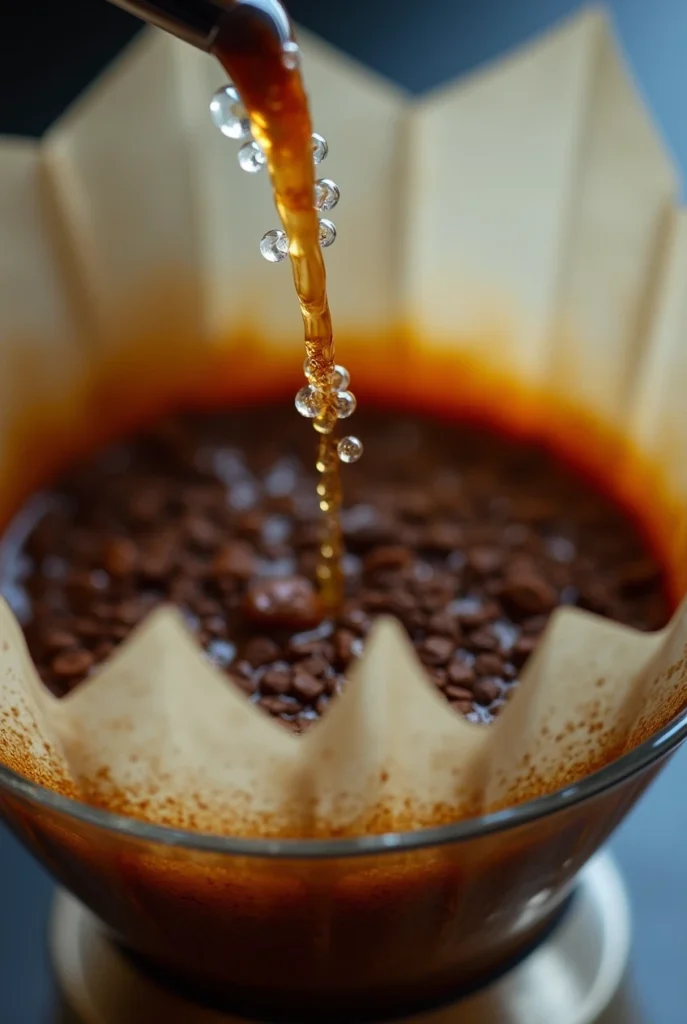
Step 3: The Main Pour Technique
After the bloom, begin your main pour in steady, controlled spirals. Pour slowly in concentric circles from the center outward, then back inward, maintaining a consistent flow rate. Aim to add water in 2-3 stages rather than all at once, with each pour taking 15-20 seconds followed by a brief 10-second pause.
Your pour technique should maintain a coffee bed that is never fully submerged by more than 1cm of water, as excessive water pressure can lead to channeling (water finding paths of least resistance), resulting in uneven extraction that can decrease flavor clarity by up to 40%.
For our 1:16 ratio example with 22g coffee, continue pouring until you reach your target of 352g total water (including the bloom water). The entire brewing process from first pour to final drip should take between 2:30-3:30 minutes.
Pro Tip: Invest in a gooseneck kettle with flow restriction—it allows 60% more control over pour precision compared to standard kettles, significantly affecting extraction uniformity.
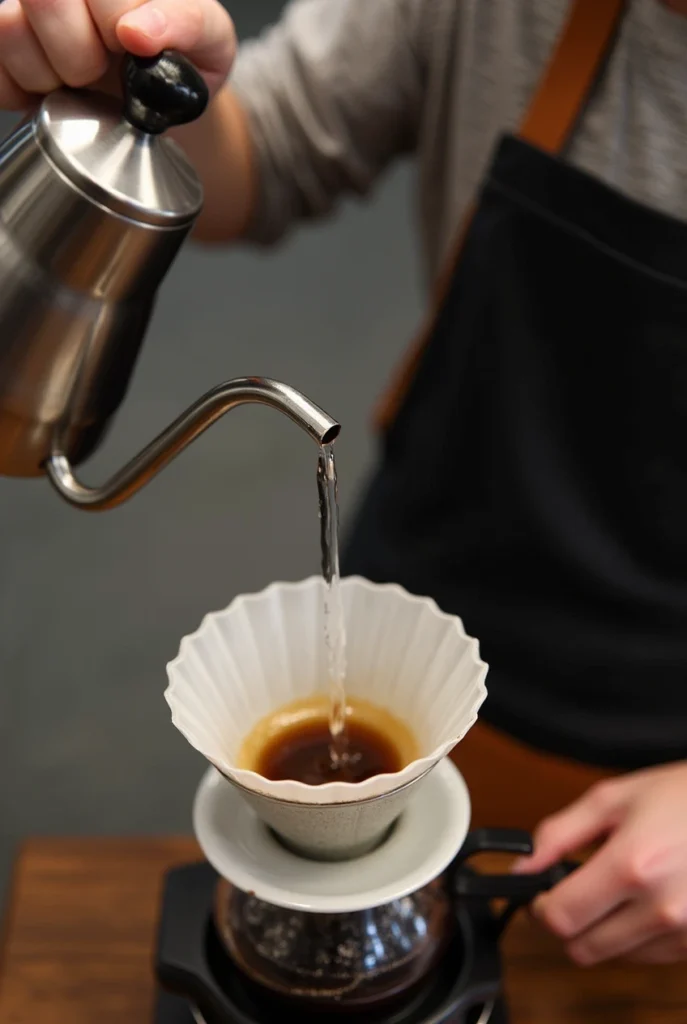
Step 4: Observe and Adjust Your Pour Over Coffee Ratio
The perfect pour over coffee ratio isn’t universal—it requires personalization. Watch the drawdown rate (how quickly water flows through the coffee bed) as a key indicator. If water flows through too quickly (under 2:30 total brew time), your grind may be too coarse. If it takes longer than 3:30, your grind may be too fine.
The shape of the coffee bed after brewing also tells a story—it should be relatively flat, indicating even extraction. A cone-shaped bed suggests channeling occurred, potentially extracting up to 30% less flavor from the center grounds.
Pro Tip: Keep a brewing journal to track your adjustments. Find your perfect pour over coffee ratio by testing between 1:15 (stronger) and 1:17 (lighter). Professional baristas report that this 1-point ratio adjustment can modify perceived strength by approximately 15% while maintaining optimal extraction.
Step 5: Taste and Refine
The ultimate test is in the tasting. Professional coffee evaluation focuses on acidity, body, sweetness, and finish. A properly executed pour over at the ideal ratio should deliver a cup with bright but balanced acidity, medium body, natural sweetness, and a clean, lingering finish.
If your coffee tastes sour or lacks sweetness, you’re likely under-extracting—try a finer grind or slightly hotter water. If it tastes bitter or astringent, you’re likely over-extracting—adjust to a coarser grind or slightly lower water temperature. Through iterative refinement, you’ll discover your perfect pour over coffee ratio and technique, tailored to your specific taste preferences.
Pro Tip: Wait approximately 3-5 minutes before evaluating your coffee. Studies show that optimal flavor perception occurs when coffee has cooled to 140-155°F (60-68°C), revealing 30% more flavor notes than when tasted at brewing temperature.
Nutritional Information
Standard Pour Over Coffee (12oz/350ml, 1:16 ratio, black):
- Calories: 2-5 kcal
- Fat: 0g
- Protein: 0.3g
- Carbohydrates: 0g
- Caffeine: 90-150mg (varies by bean variety and roast level)
- Antioxidants: Contains chlorogenic acids and melanoidins which provide approximately 200-550mg of antioxidant compounds per cup
Health Benefits Data:
- Regular coffee consumption is associated with a 23-50% reduced risk of Type 2 diabetes according to multiple longitudinal studies
- Contains 4x more antioxidants than green tea per serving
- Enhances cognitive function by 5-10% for 2-4 hours after consumption
- Improves physical performance by 11-12% on average when consumed 30-60 minutes before exercise
Note: Nutritional values represent black coffee only. Adding dairy, sweeteners, or other ingredients will significantly alter these values.

Healthier Alternatives for the Recipe
Lower Caffeine Options:
- Create a “half-caf” blend by mixing 50% regular and 50% decaffeinated beans while maintaining the same pour over coffee ratio
- Swiss Water Process decaffeinated beans offer 99.9% caffeine reduction while preserving 85-90% of flavor compounds compared to chemical decaffeination processes
- Try naturally lower-caffeine bean varieties like Laurina or Aramosa, which contain approximately 40-60% less caffeine than typical Arabica
Enhanced Nutritional Profiles:
- Add a pinch (0.5g) of Ceylon cinnamon to your grounds before brewing for blood sugar regulation benefits and enhanced flavor complexity
- For cognitive enhancement, add 0.5-1g of lion’s mane mushroom powder to the grounds (imperceptible taste at this quantity)
- Use tulsi (holy basil) infused water for brewing to add adaptogenic properties without altering the essential pour over coffee ratio
Dietary Accommodations:
- For intermittent fasting practitioners: black coffee contains <5 calories and won’t break a fast
- For keto enthusiasts: add 1 teaspoon of MCT oil and blend briefly for sustained energy without disrupting ketosis
- For plant-based diets: oat milk foams similarly to dairy when heated to 150°F and adds only 30-40 calories per tablespoon
Serving Suggestions
Complementary Pairings:
- Morning Serving: Pair with dark chocolate (72%+ cacao) to enhance the coffee’s natural sweetness—the flavonoids in both create a flavor synergy that enhances perception of fruit notes by up to 25%
- Afternoon Serving: Accompany with unsalted nuts like almonds or walnuts whose healthy fats cleanse the palate, allowing you to experience the coffee’s full flavor spectrum
Temperature Progression Experience:
- Hot Phase (170-155°F): Appreciate the aromatic intensity and initial acidity
- Warm Phase (155-130°F): Experience the peak flavor development and sweetness emergence
- Room Temperature Phase (<130°F): Discover nuanced flavor notes that are often masked at higher temperatures
Presentation Enhancements:
- Serve in pre-warmed, thin-walled ceramic vessels which maintain temperature 15% longer than thick-walled mugs while providing superior sensory experience through rim thickness
- For iced pour over, brew at a stronger 1:10 ratio directly over ice (using half your water hot, half as ice) to preserve aromatic compounds that would otherwise volatilize
- For guests, create a “tasting flight” of the same beans prepared at three different pour over coffee ratios (1:15, 1:16, 1:17) to demonstrate how ratio affects flavor profile
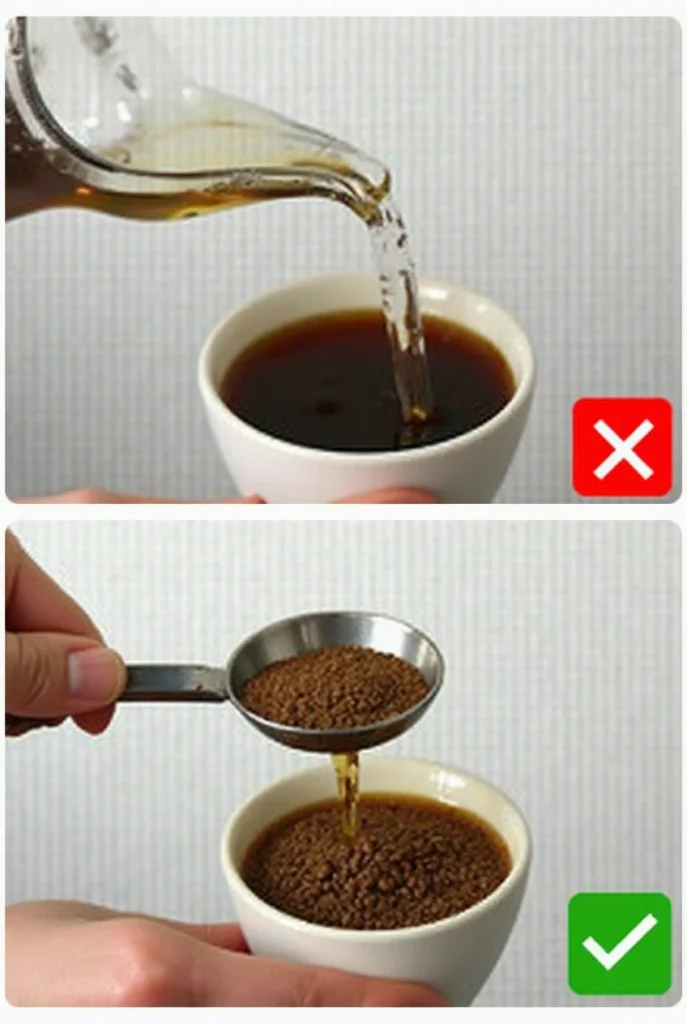
Common Mistakes to Avoid
Ratio and Measurement Errors:
- Eyeballing Measurements: Visual estimation of coffee amounts can be off by 25-40%, dramatically affecting strength and extraction. Always measure with a scale.
- Inconsistent Ratios: Changing your pour over coffee ratio between brews makes it impossible to calibrate and improve your technique. Standardize your approach.
- Water Temperature Extremes: Too hot (>205°F) extracts excessive bitter compounds; too cool (<195°F) under-extracts, missing 20-30% of soluble flavor compounds. Use a temperature-controlled kettle or wait 30 seconds off boil.
Technique Failures:
- Pouring Too Aggressively: High-impact pouring creates channels in the coffee bed, leading to uneven extraction with some areas over-extracted and others under-extracted by as much as 15-20%.
- Neglecting the Bloom: Skipping the bloom phase results in uneven saturation, with hydrophobic CO2 bubbles blocking water access to up to 30% of your coffee grounds.
- Inconsistent Pouring Patterns: Focusing water repeatedly on the same areas creates “hot spots” of over-extraction, increasing bitterness by 35-40% in affected regions.
Equipment Oversights:
- Dirty Equipment: Mineral build-up and coffee oils can impart rancid flavors and affect flow rate. Regular cleaning removes compounds that can introduce off-flavors affecting 25-35% of your brew’s clarity.
- Grinder Inconsistency: Blade grinders produce particle size variations of up to 400% compared to burr grinders’ 50-100% variation, dramatically affecting extraction uniformity.
- Filter Substitution: Using the wrong filter thickness can alter flow rate by 15-45%, changing extraction time and consequently flavor profile. Always use filters designed for your specific brewer.
Storing Tips for the Recipe
Coffee Bean Storage:
- Store whole beans in an opaque, airtight container away from light, heat, moisture, and strong odors
- Avoid storing in the refrigerator, which can introduce moisture and condensation, degrading beans 50% faster than proper room temperature storage
- For optimal freshness, buy beans in small quantities (2-week supply maximum) as coffee loses 15-20% of its aromatic compounds weekly after roasting
Pre-Measuring Convenience:
- For efficiency, pre-measure single servings of whole beans (not ground) into small airtight containers for grab-and-go brewing
- If traveling, use oxygen-absorbing packages to extend freshness by up to 30%
- Label beans with roast date and origin—flavor peaks 7-14 days after roasting for most beans and gradually diminishes thereafter
Water Preparation:
- If using filtered water, prepare larger batches and store in glass containers for up to 3 days
- For areas with problematic tap water, consider preparing “mineral recipes” by adding specific mineral combinations to distilled water for optimal extraction (Third Wave Water packets offer standardized mineralization)
- Pre-heating water and storing in an insulated container can reduce morning preparation time by 40-50% while ensuring temperature stability
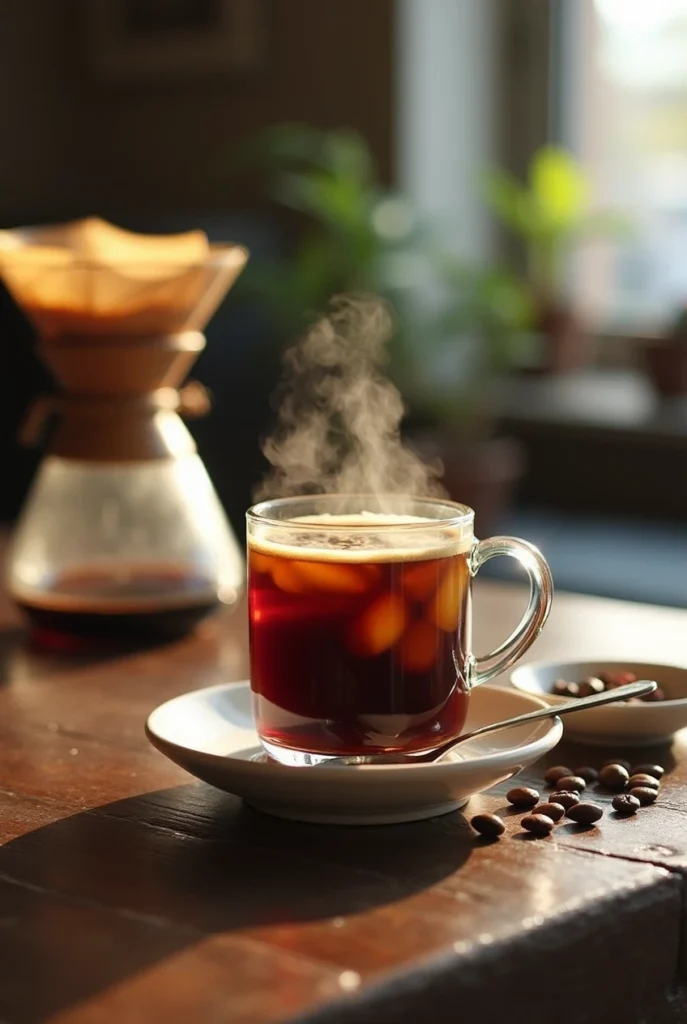
Conclusion
Mastering the pour over coffee ratio is the pivotal factor in transforming your morning brew from ordinary to extraordinary. Through meticulous attention to your coffee-to-water relationship, proper blooming, controlled pouring technique, careful observation, and thoughtful tasting, you’ll discover a depth of flavor that showcases the true potential of specialty coffee beans.
Ready to elevate your coffee experience? Try these five steps tomorrow morning and taste the remarkable difference a proper pour over coffee ratio can make! Share your results in the comments section below, join our coffee community discussions, and subscribe to our newsletter for more brewing insights and techniques to perfect your daily ritual.
FAQs
Q: What is the ideal pour over coffee ratio for beginners? A: For beginners, start with a 1:16 ratio (1 gram of coffee to 16 grams of water). This produces a balanced cup that works well with most beans. For a standard 12oz cup, use 22g coffee and 352g water. As you develop your palate, you can adjust toward 1:15 for a stronger cup or 1:17 for a lighter brew.
Q: How does grind size affect my pour over brewing? A: Grind size directly impacts extraction rate and flavor balance. Too fine a grind can lead to over-extraction (bitter, astringent flavors) and extended brew times beyond 4 minutes. Too coarse a grind results in under-extraction (sour, weak flavors) and rapid brew times under 2 minutes. For pour over, aim for a medium-fine grind similar to sea salt or granulated sugar.
Q: Does water quality matter that much? A: Absolutely. Water constitutes over 98% of your final cup. Studies show that optimal coffee water contains 75-150 ppm of total dissolved solids with specific ratios of calcium, magnesium and bicarbonate. Chlorinated tap water can reduce aroma compounds by up to 30%, while excessively hard water can under-extract by up to 25%. Filtered water significantly improves extraction quality and flavor clarity.
Q: How fresh do my coffee beans need to be? A: For optimal flavor, use beans within 2-4 weeks of their roast date. Coffee reaches peak flavor typically 7-14 days after roasting as CO2 levels stabilize. Very fresh coffee (1-3 days off roast) may produce excessive blooming and uneven extraction due to high CO2 content. Beans older than 4 weeks will have lost 40-50% of their aromatic compounds, though they remain drinkable.
Q: Should I adjust my pour over coffee ratio for different roast levels? A: Yes. Darker roasts extract more readily than lighter roasts due to more porous cell structures and soluble compounds. For dark roasts, consider a slightly lower temperature (195-200°F) and a slightly more dilute ratio (1:17). For light roasts, use water at 200-205°F and consider a slightly more concentrated ratio (1:15) to ensure proper extraction of their denser cellular structure.
Q: Why does my pour over coffee sometimes taste inconsistent even with the same beans? A: Inconsistency usually stems from variables beyond the pour over coffee ratio itself. Common culprits include: water temperature variations (±5°F can change extraction by 10-15%), inconsistent pouring techniques, grinder inconsistency, or aging beans (flavor profile changes noticeably after 7+ days from opening). Controlling these variables alongside your ratio will dramatically improve consistency.
Ready to perfect your pour over technique? Try implementing these ratio adjustments tomorrow morning and share your results in our comments section! Don’t forget to subscribe to our coffee newsletter for weekly brewing tips and special offers on our favorite single-origin beans.
Did You Try Our Recipe?
There are no reviews yet. Be the first one to write one.

